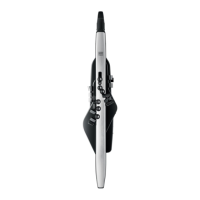48
Tone Parameters
Parameter Value Explanation
Source
Sets the MIDI message used to change the partial parameter
with the Matrix Control.
OFF Matrix control will not be used.
CC01–31, CC33–95 Controller numbers 1–31, 33–95
BEND Pitch bend
AFTER TOUCH Aftertouch
SYS-CTRL1–4
MIDI messages assigned by the SYSTEM
parameters SYS-CTRL 1–4
VELOCITY Velocity (pressure you press a key with)
KEYFOLLOW
Keyfollow (keyboard position with C4
as 0)
TEMPO
Tempo specied by the tempo assign
source
LFO1, LFO2
LFO 1
LFO 2
PIT-ENV Pitch envelope
FLT-ENV Filter envelope
AMP-ENV Amp envelope
* Velocity and Keyfollow correspond to Note messages.
* Although there are no MIDI messages for LFO 1 through
AMP Envelope, they can be used as Matrix Control. In this
case, you can change the partial settings in realtime by
playing tones.
* If you want to use common controllers for the entire AE-30,
select “SYS-CTRL1”–”SYS-CTRL4.” MIDI messages used
as System Control 1–4 are set with the System Control
Source1–4.
NOTE
There are parameters that determine whether or not Pitch
Bend, Controller Number 11 (Expression) and Controller
Number 64 (Hold 1) are received (p. 47). When these
settings are “ON,” and the MIDI messages are received, then
when any change is made in the settings of the desired
parameter, the Pitch Bend, Expression, and Hold 1 settings
also change simultaneously. If you want to change the
targeted parameters only, then set these to “OFF.”
Parameter Value Explanation
Destination 1–4
Selects the partial parameter that is to be controlled when
using the Matrix Control. The following parameters can be
controlled.
When not controlling parameters with the Matrix Control, set
this to “OFF.”
Up to four parameters can be specied for each Matrix
Control, and controlled simultaneously.
OFF Matrix control will not be used.
PCH Changes the pitch.
CUT Changes the cuto frequency.
RES
Emphasizes the overtones in the region
of the cuto frequency, adding character
to the sound.
LEV Changes the volume level.
PAN Changes the pan.
CHO Changes the amount of chorus.
REV Changes the amount of reverb.
PIT-LFO1
Changes the vibrato depth.
PIT-LFO2
FLT-LFO1
Changes the wah depth.
FLT-LFO2
AMP-LFO1
Changes the tremolo depth.
AMP-LFO2
PAN-LFO1
Changes the eect that the LFO will
have on pan.
PAN-LFO2
LFO1-RATE Changes the speed of the LFO cycles.
The speed will not change if LFO Rate is
set to “note.”
LFO2-RATE
PIT-ATK
Changes the Time 1 of the PITCH
envelope.
PIT-DCY
Changes the Time 2 and Env Time 3 of
the PITCH envelope.
PIT-REL
Changes the Time 4 of the PITCH
envelope.
FLT-ATK
Changes the Time 1 of the FILTER
envelope.
FLT-DCY
Changes the Time 2 and Env Time 3 of
the FILTER envelope.
FLT-REL
Changes the Time 4 of the FILTER
envelope.
AMP-ATK
Changes the Time 1 of the AMP
envelope.
AMP-DCY
Changes the Time 2 and Env Time 3 of
the AMP envelope.
AMP-REL
Changes the Time 4 of the AMP
envelope.
TONE/PARTIAL/MATRIX CONTROL
Ordinarily, if you wanted to change partial parameters using an external MIDI device, you would need to send System Exclusive messages-MIDI messages
designed exclusively for the AE-30. However, System Exclusive messages tend to be complicated, and the amount of data that needs to be transmitted can
get quite large.
For that reason, a number of the more typical of the AE-30’s partial parameters have been designed so they accept the use of Control Change (or other) MIDI
messages for the purpose of making changes in their values. This provides you with a variety of means of changing the way tones are played.
The function which allows you use MIDI messages to make these changes in realtime to the partial parameters is called the “Matrix Control.”
Up to four Matrix Controls can be used in a single tone.
To use Matrix Control, you specify which MIDI message (Source) controls which parameter (Destination) and how deeply (Sens: sensitivity).

